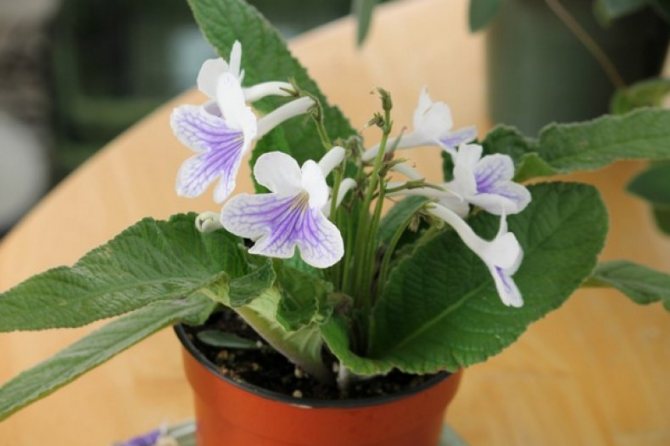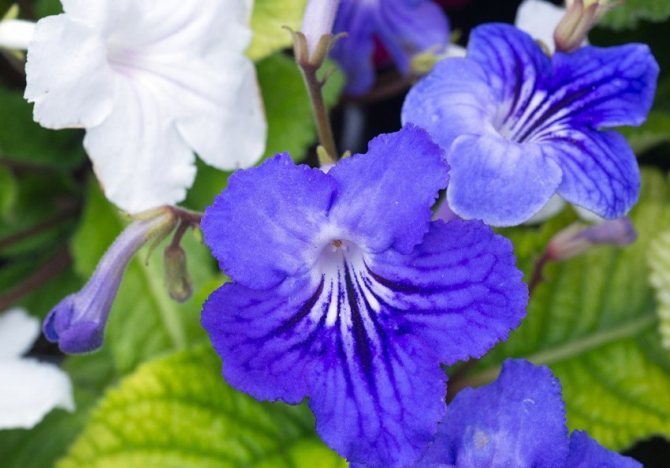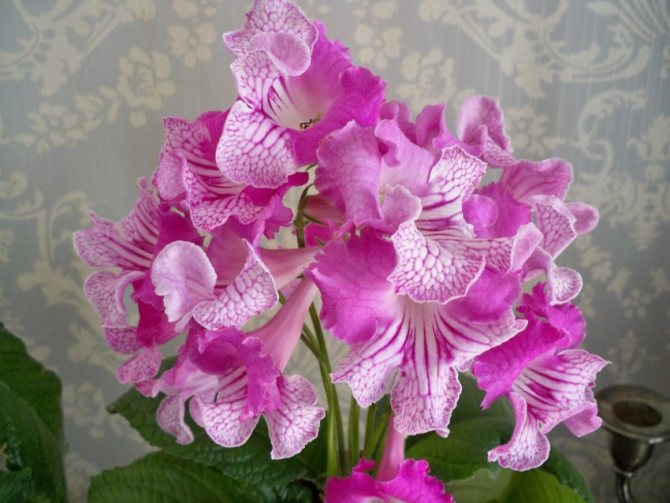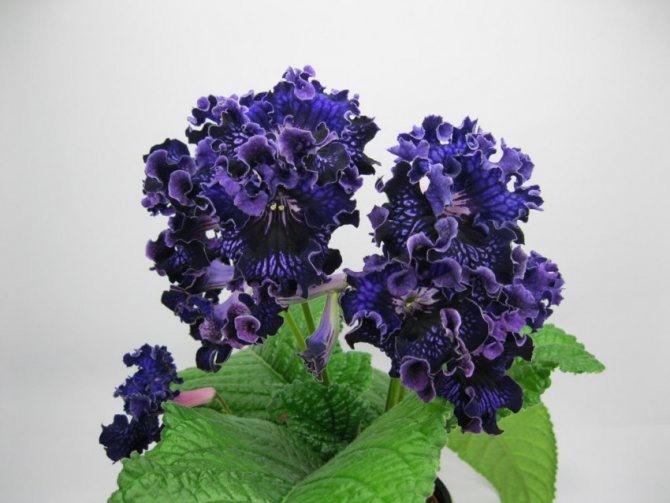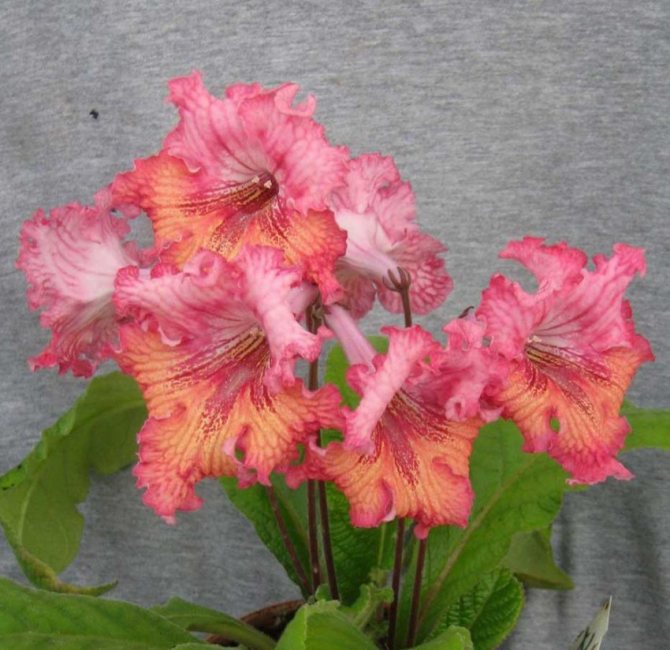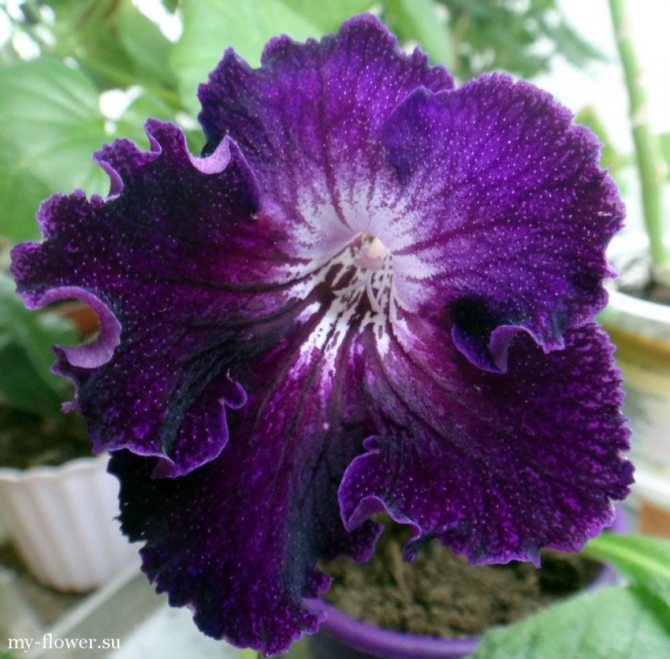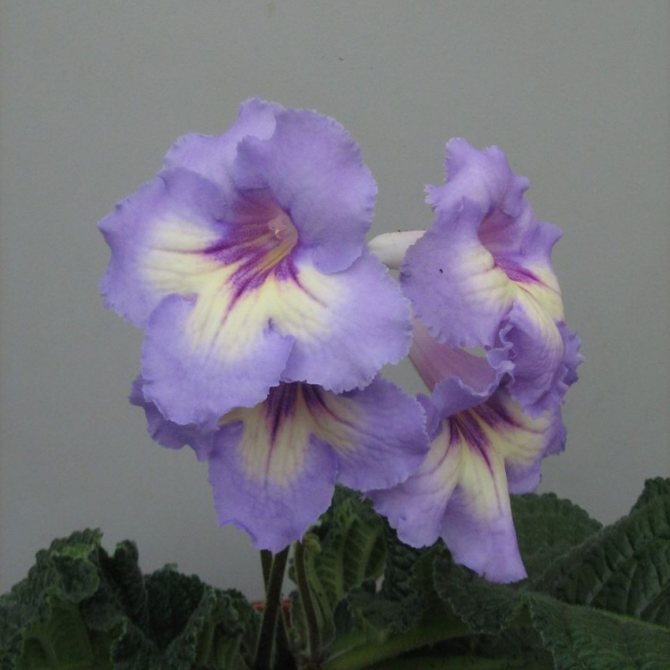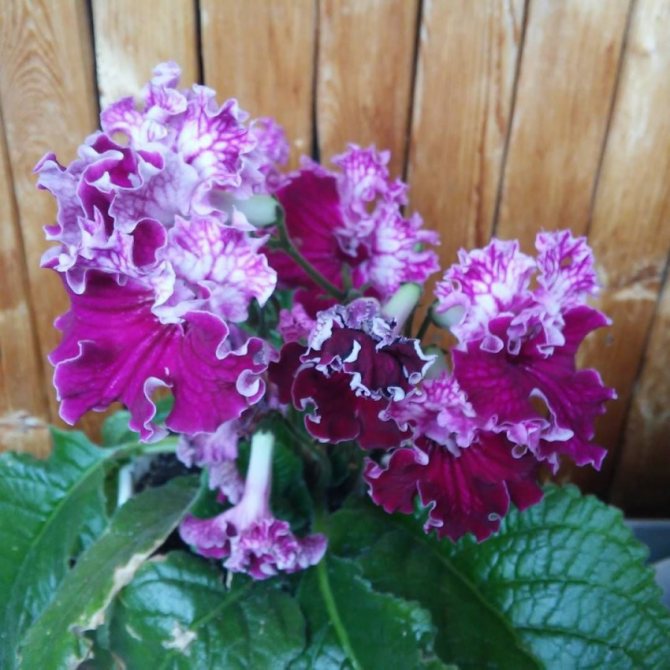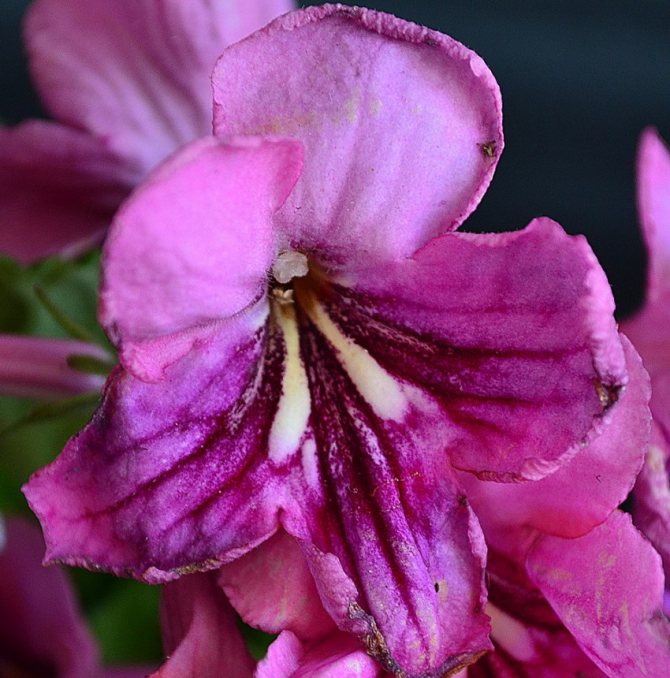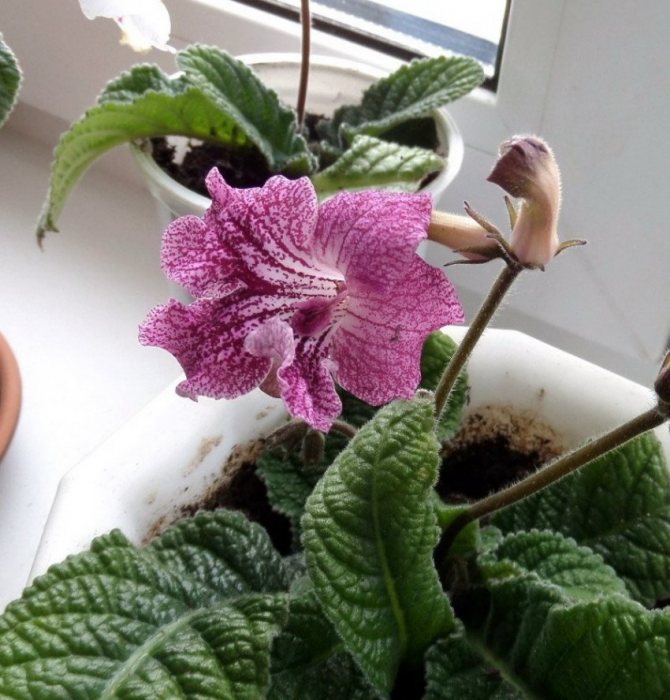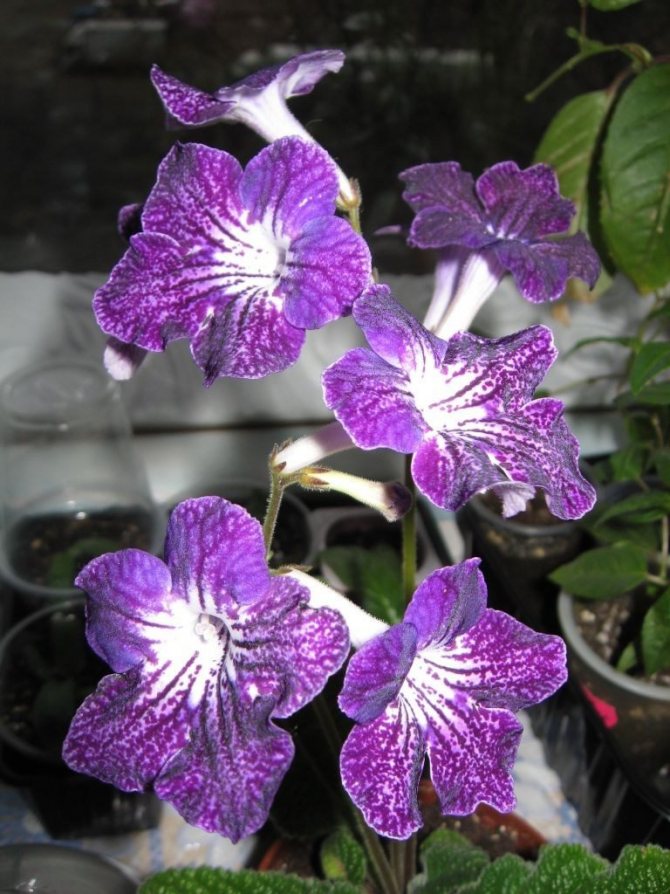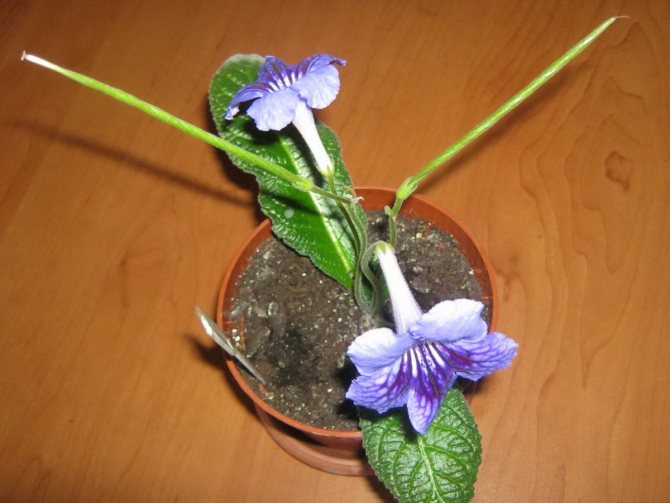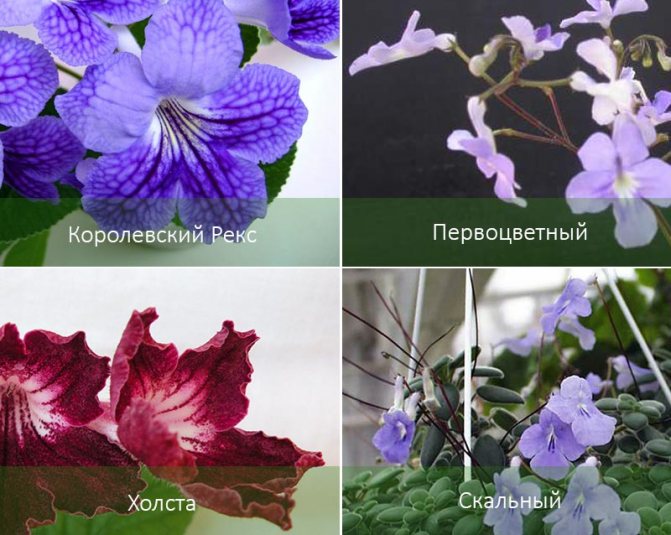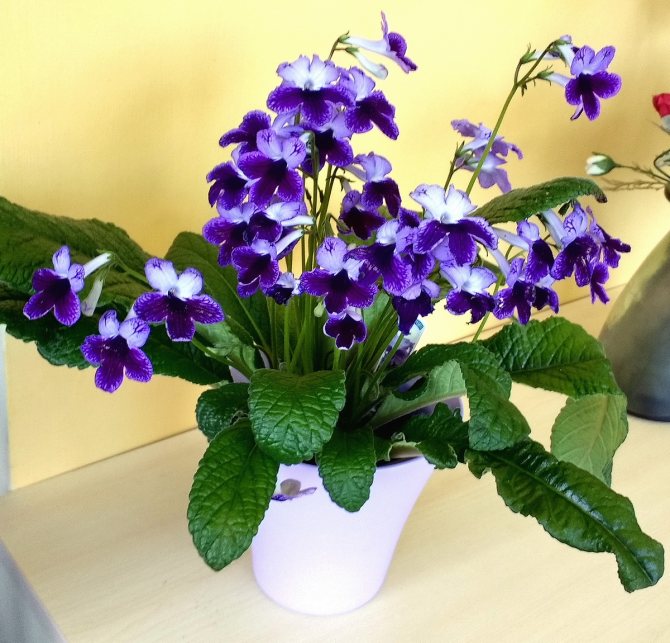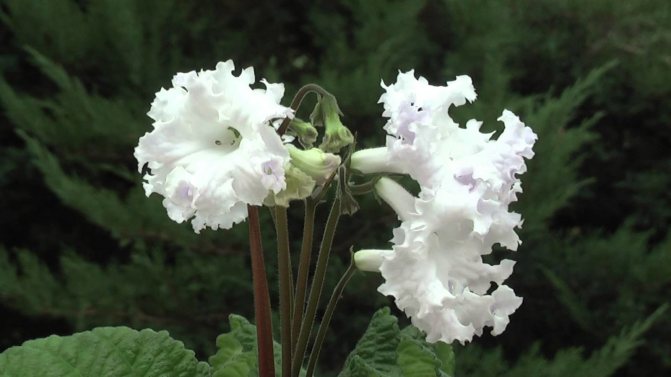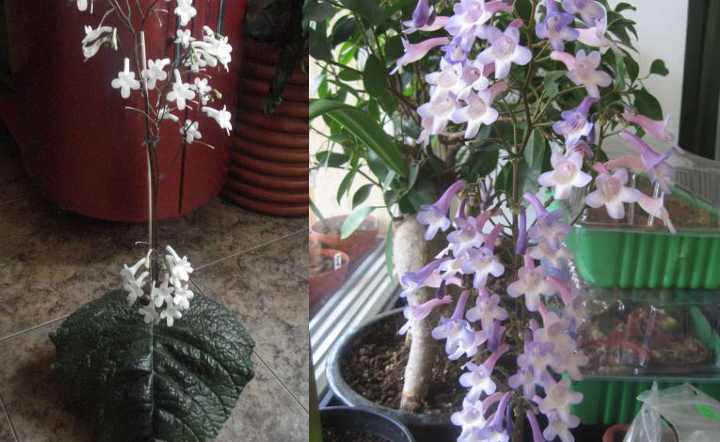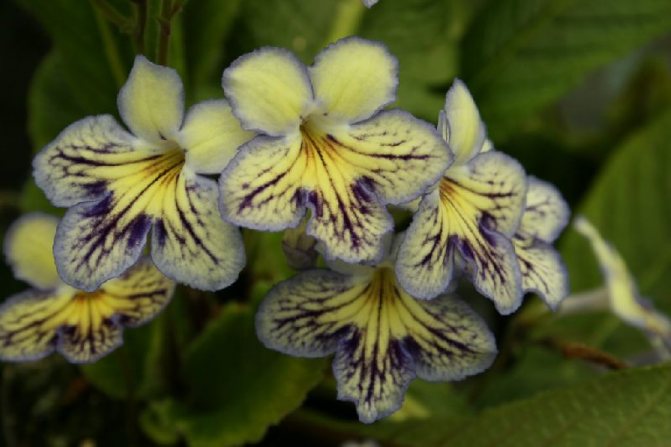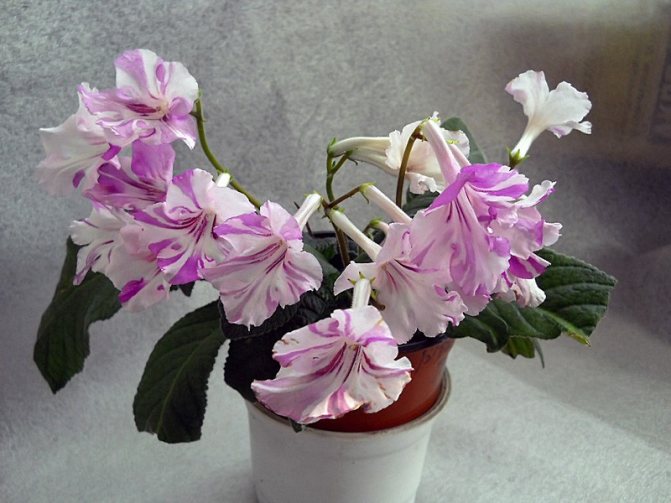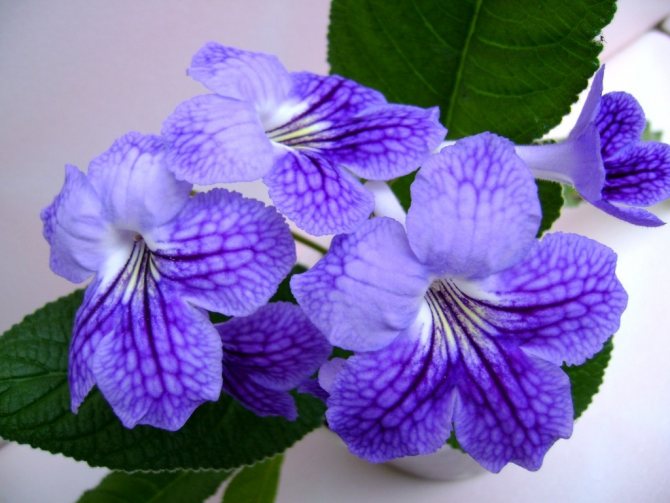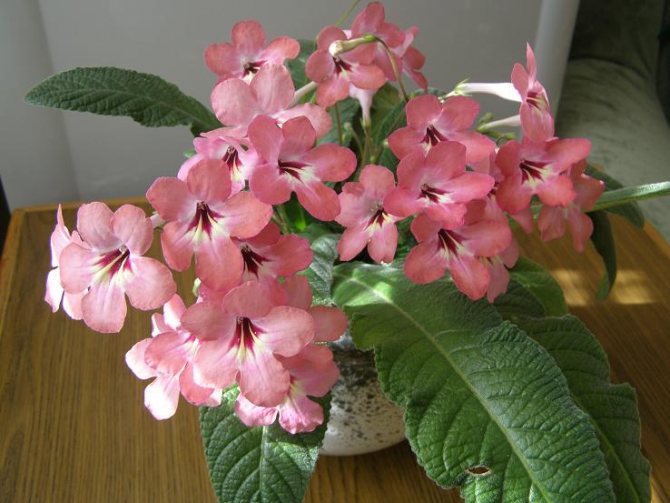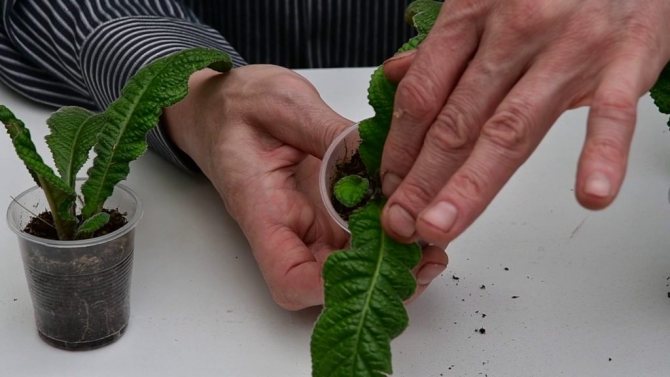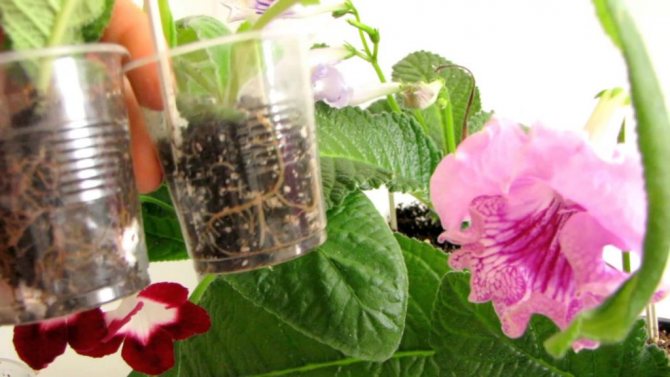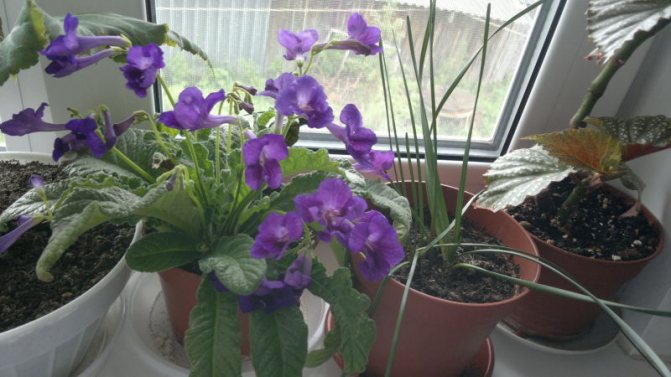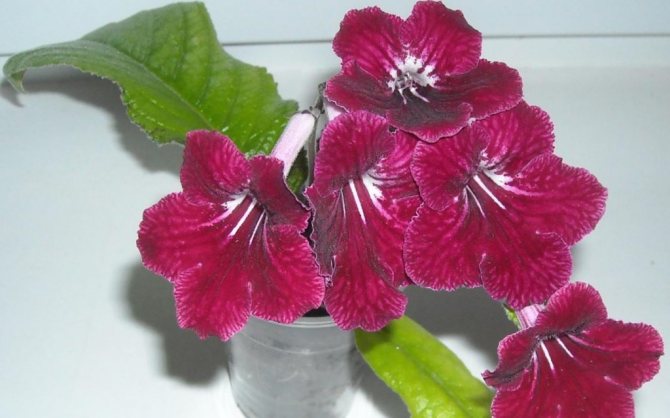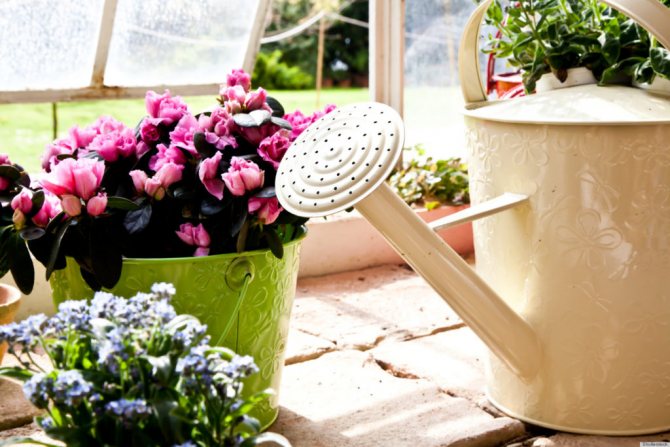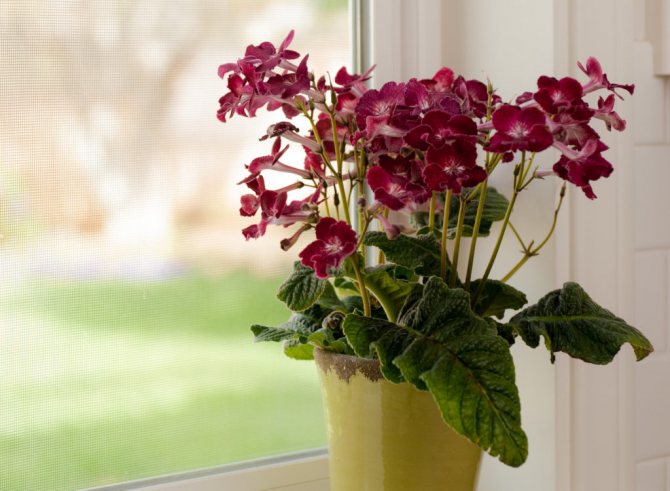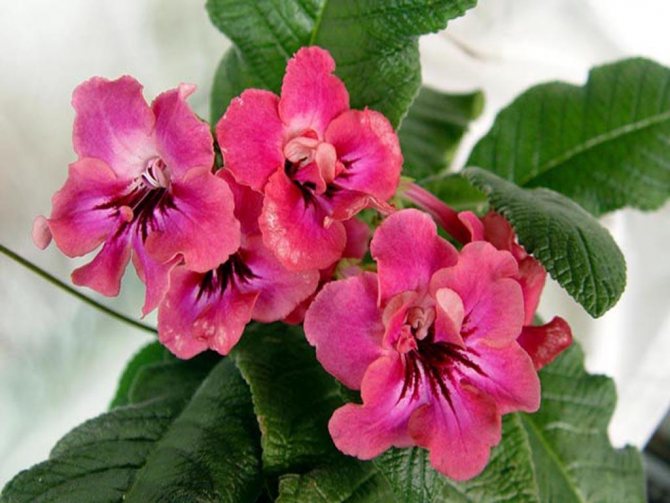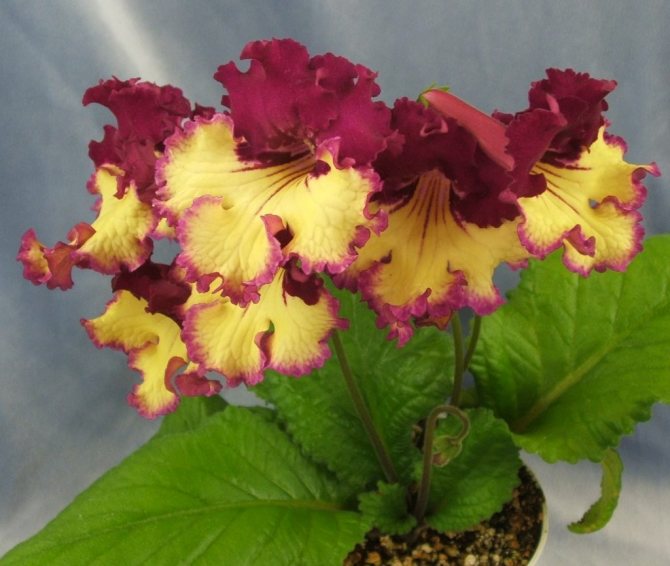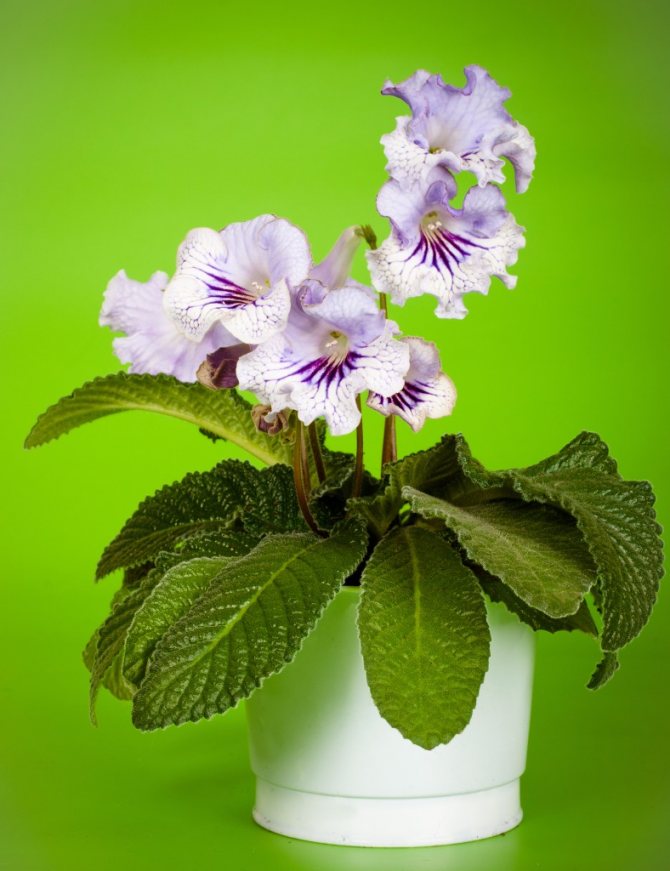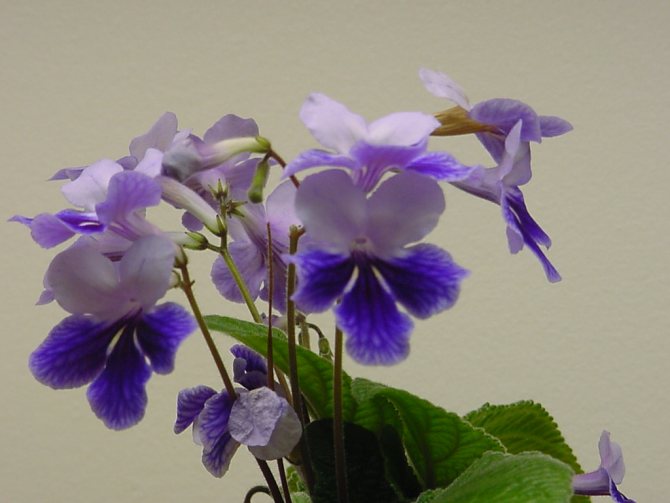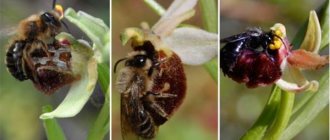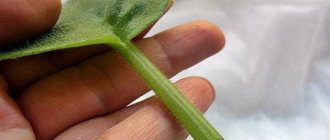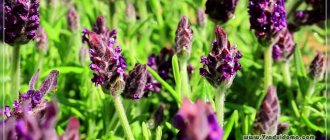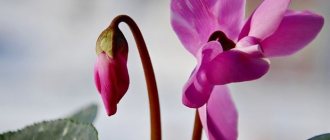Streptocarpus is a wonderful indoor flower, which, despite the fact that it comes from the tropics, has perfectly adapted to life in an ordinary city apartment, grows well and blooms profusely with unusual bright numerous flowers. We will talk about the different ways of reproduction of streptocarpus further.
Botanical reference
Streptocarpella is a perennial ampelous plant, has a high decorative effect, even without flowering. Small leaves, 2 - 3 cm in size, velvety and fleshy, malachite shade, densely covering long stems give it a special charm. The shoots of an adult plant can grow up to 50 cm, and the diameter of the bush can reach 20 - 30 cm. It lends itself well to formation, it can also be grown as a bush.
Streptocarpella grows and blooms very quickly, produces peduncles as early as 3 months after planting.
They emerge from the leaf sinuses along the entire stem, grow up to 8 cm long, thin and elastic, like wires, at the ends of which there are several delicate tubular small flowers (2 - 3 cm), reminiscent of a violet. The petals are lilac, the tube is snow-white. The plant blooms for a long time and magnificently, despite the rapid fall of the corollas (3 - 5 days), releasing more and more flower stalks.
Modern specimens are particularly decorative. Thanks to the selection, there are unique varieties and hybrids of pink, blue, purple, white and multi-colored shades that can decorate an interior in any style.
In large rooms, ampelous streptocarpella can be used in space zoning, adding coziness to the atmosphere. The airy flower cloud of streptocarpella visually expands the area of the room with a low ceiling. Being a bright accent, it will add lightness and grace to any interior.
In warm weather, the flower will decorate the balcony, will become an indispensable attribute of the veranda or terrace of a country house.
Description
The plant has no stem, the leaf plates are bright emerald, wrinkled, lanceolate, with pronounced branched veins, up to 30 cm long, covered with villi, thick, collected in a large rosette. Some hybrids have terry.
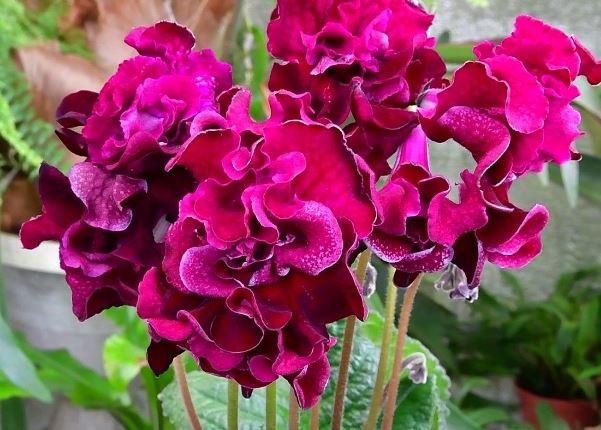
In the axils of the leaves, flower stalks are formed of 8-10 pieces, 20-25 cm long, from which buds grow. The flowers of streptocarpus are funnel-shaped, 2–9 cm in diameter, with five fused petals. Their edges are rounded, wavy. Depending on the variety, the petals are simple, double, densely double, corrugated.
The palette is white, lilac, lavender, cherry, cream, pale pink, light yellow. In one variety, there are several shades, there are specks, stains.
The root system is represented by superficial adventitious roots. The seeds are formed in a twisted pod, therefore the name is translated from Greek as "twisted box".
Streptocarpus are classified into three types:
- with one large leaf and peduncle;
- creeping or stem (few in number);
- stemless, form rosettes.
The latter include most hybrids. The most popular are Rocky, Sea patterns, Envy of the Gods, Spring Dreams, Royal.
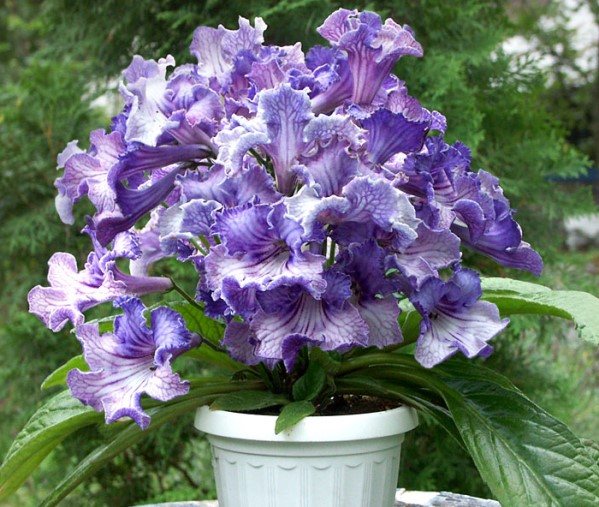

Even a photo will not convey the beauty of their delicate flowers.
The main types and varieties of streptocarpella
Some hybrid varieties are especially attractive:
- Blue Harmony or Bavarian Bell (Streptocarpella Blue Concord), a branched bush with long stems, small pubescent leaves and flowers, up to 2.5 cm in light blue or blue hue;
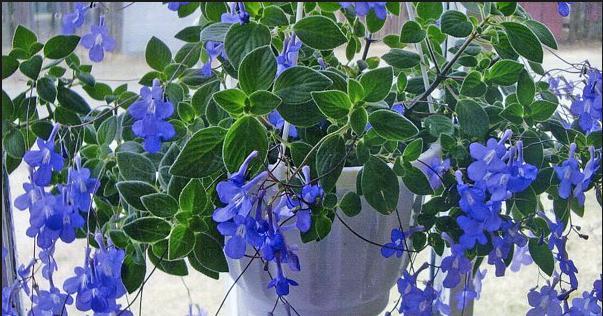

- Albatross (Streptocarpella Albatross) - white flowers and yellow funnel (pictured on the left);
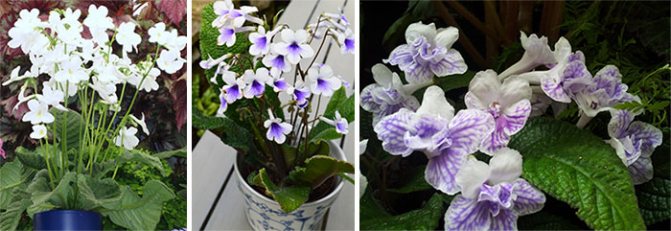

- Blue Moon (Streptocarpella Blue Moon) - blue or lilac small flowers up to 1 cm and a white tube;
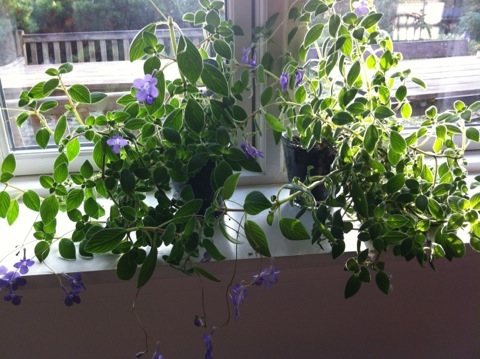

- Butterfly (Streptocarpella White Butterfly) - with small soft leaves and white bell-shaped flowers;
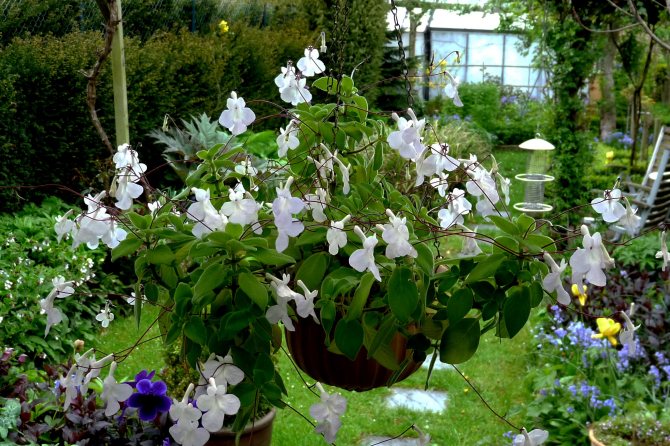

- Iris (Streptocarpella Butterscotch) - delicate light green leaves and white lavender bells.
Varieties mixed with succulent forms have also been bred, for example:
- Streptocarpella Glandulosissimus - the plant has a juicy thick burgundy trunk, from which numerous long shoots with a bright blue bell at the end extend. The leaves are small, emerald hue, the flower is actively bushes;
- Streptocarpella Caulescens Pallescens - an erect succulent smooth trunk is covered with small pale green pubescent leaves and a large number of small lilac bluebells with lilac stripes.
And there are many other varieties that can create coziness and a comfortable atmosphere in the home.
Reproduction by the "toaster" method
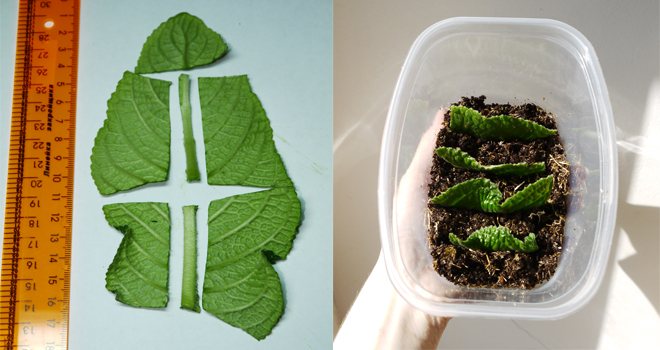

Sometimes, in order to propagate streptocarpus from a leaf, the so-called "toaster" method is used. It consists in removing the central vein from a healthy leaf 4 - 5 cm long. Both halves of the leaf are slightly dried, then the slices are treated with rooting stimulants and placed in a pot with a light earthy mixture, not deep, on the floor, cm. It is very similar to two pieces of bread in a toaster. Cover the planting with foil. In the greenhouse, nodules with leaves will soon begin to appear along the cuts - the so-called babies, which you will plant from the mother leaf in separate pots as soon as they grow a little. This will happen in three to four months. Soon, these bushes may bloom.
Pros and cons of growing a plant
The flower is generally unpretentious, but picky about the conditions of detention. There are no trifles for growing, and most importantly for the flowering of a plant, everything matters for it: lighting, temperature regime, air humidity, soil composition, and even the size of the pot. Seeing and enjoying the beauty of flowering takes a lot of effort.
The difficulties include untimely pinching. If the grower is not experienced and pinches the shoots of a young plant, then flowering is postponed for a long time.
Otherwise, only pluses:
- high decorativeness;
- active growth;
- long flowering, short dormant period;
- shade tolerance;
- the ability to renew;
- multiplicity of varieties.
With close attention, streptocarpella is rarely affected by infections.
Bloom
The buds bloom in the spring, pleasing with a beautiful view until late autumn.
In winter, with additional lighting, flowering continues. If there is little light, the growth of streptocarpus slows down, it sheds its leaves.
Some varieties may not bloom in winter, even with phytolamps. Experts recommend providing streptocarpus with a rest period to restore strength, remove dry, weakened shoots.
In the fall, the streptocarpus babies bloom, they are cut off, leaving one. This will keep the shrub strong and healthy in the future.
Landing soil
For the full growth and flowering of streptocarpella, the soil needs a nutritious, loose, easily permeable water and air, because the flower (like all Gesneriaceae) breathes by its roots. Structure:
- humus or black soil (1 part);
- high-moor peat (1 hour);
- sand (1 hour);
- vermiculite or perlite.
It is also necessary to add charcoal to the composition, since the acidity of the soil should become neutral. You can use ready-made soil for Saintpaulia or Gloxinia.
Other possible difficulties
When growing streptocarpus, beginners face different difficulties.


| Problem | Possible reasons |
| Leaves with yellow spots | Sunburn |
| The tips of the plates dry up | Low air humidity |
| The bush withers even with regular watering | Decay of roots |
| Rusty stains | Excessive watering, nitrogen fertilization |
If a the leaves are pale, what to do in this case? In some varieties, the plates partially brighten before dormancy, then dry out. But the reason may be poor lighting, lack of fertilizers. In order to avoid difficulties, all agricultural rules should be followed.
Thanks to its fabulous palette, the unpretentious streptocarpus will bring variety to the flower world. They will decorate any room, serve as a wonderful decor, create a festive atmosphere.
When to plant and replant
Taking into account the reviews of experienced flower growers, you can plant cuttings immediately in the ground under the jar or wait for the roots to appear in the water, and you can transplant the flower at any time of the year after the end of the dormant phase.
Young streptocarpellas change the soil every year, and after 5 - 7 years, the plant must be renewed, since the stems become woody and become less attractive.
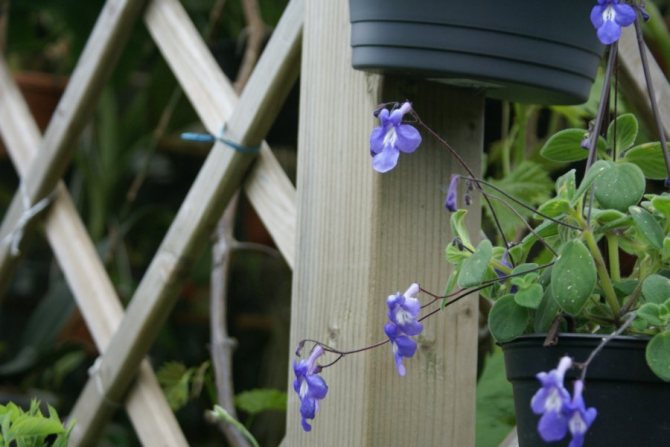

Reproduction using leaf veins
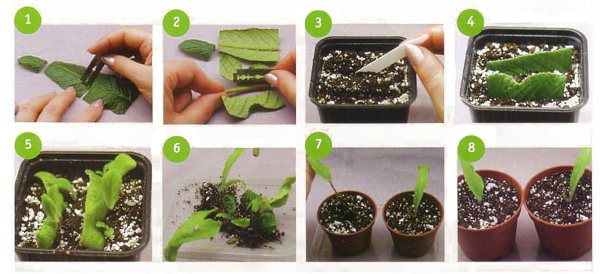

To reproduce streptocarpus with a leaf fragment, you need to cut the leaf into several parts, each of which must have a part of a central or large lateral vein. Each piece of leaf is planted in the same way described above, at right angles to the soil, because at the point where the vein touches the ground, its roots will begin to form and a baby will appear. Usually, shoots begin to appear after one and a half to two months.
Landing progress
It is very important to properly plant the streptocarpella sprout. Given the superficial root system of the plant, the pot is chosen wide and shallow with a drainage hole to drain excess moisture.
Before filling the pot with a substrate, the bottom is covered with a large amount of drainage (expanded clay, pebbles, clay shards).
Streptocarpella bushes well, so you should not thicken the pot with several shoots, 2 - 3 branches are enough, you can have different shades - this will make the flower even more attractive.
Having planted a seedling in a flowerpot, cover it with a glass jar. In such greenhouse conditions, the sprout will root better. We set up a greenhouse in a warm place (+ 25o), with good lighting. Do not forget to air it daily. Water as the topsoil dries out. When new seedlings appear, remove the jar.
Dividing the bush into parts when transplanting an adult plant
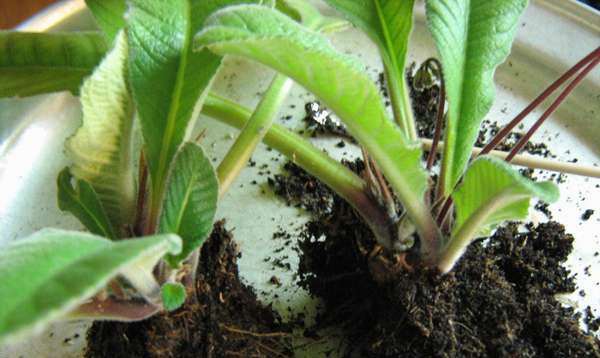

When the mother bush of streptocarpus has grown too much, and it is already cramped in the pot, and thickened leaf rosettes cause a reduction in flowering, it is most correct to make several copies of new plants from your pet. To do this, remove the bush from the pot, carefully free its roots from the soil and cut the plant bush together with the flower root system into two or three parts with a sharp, clean tool (knife, blade). Make sure that each part has not only roots, but also leaves with a growing point. Sometimes from one overgrown bush, five new young flowers are obtained at once. Treat each part on the cut with crushed charcoal or activated carbon. Prepare pots not deep, but spacious. Lay 1 cm of expanded clay at the bottom. On it - the same amount of land. Use the soil for ornamental flowering indoor plants. Plant new bushes in pots up to the root collar, making sure that the soil fills all the voids in the pot and covers all the roots. Water the seedlings gently along the sides of the pot with lukewarm water. Place in a bright place prepared for them (but not in the sun) under the film. The bushes quickly take root and soon begin to bloom.
Streptocarpella care rules
The features of the flower are amazing. If you create constant comfortable conditions throughout the year, then the plant will bloom continuously. In an apartment it is very difficult, but possible if you make an effort.
Lighting
It is important to remember that streptocarpella needs at least 14 hours of light for full growth and lush flowering.In autumn and winter, when there is a short daylight hours, it is necessary to illuminate it with phytolamps.
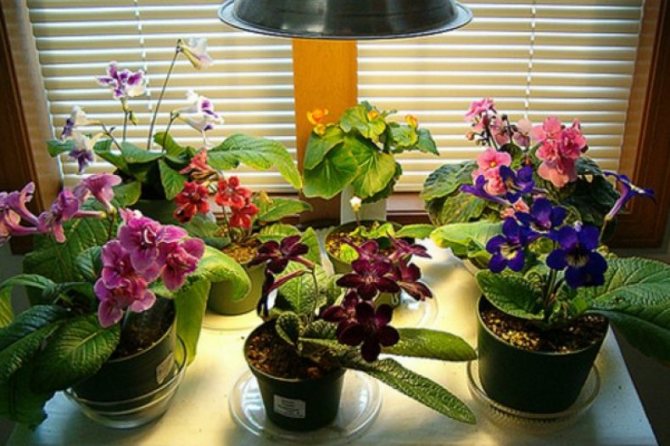

Streptocarpella supplementary lighting is an important element of care
Watering
With shallow roots close to the soil surface, irrigation is required regularly and moderately. Water after drying the top layer. It is necessary that the inside of the earthen lump is always moist, but not flooded. Drying out of the soil affects the plant by curling the leaves, and stagnant water - rotting of the roots. The water from the pallet must be removed immediately.
It is also important that moisture does not get on the fleecy leaves - this will worsen the appearance, and also contribute to the development of rot.
Air humidity
High humidity is an integral part of the correct development of the bush, especially with a dry atmosphere. You should carefully humidify the air around the flower, avoid getting drops on the leaf surface. It is recommended to install additional devices to maintain constant humidity:
- tray with wet pebbles, expanded clay, moss;
- vessels with water;
- household gadgets for air humidification.
A comfortable atmosphere close to natural tropical conditions is the key to the health of streptocarpella.
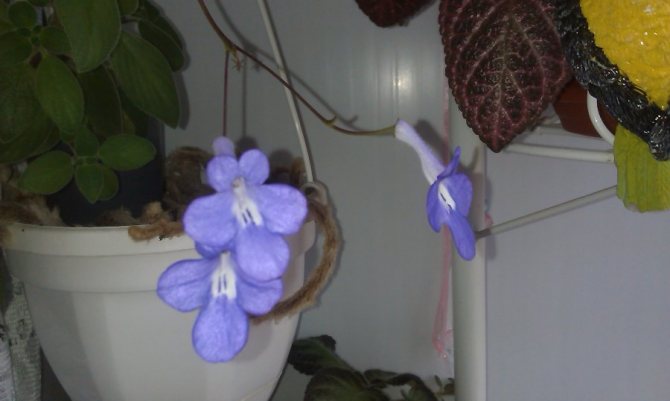

Temperature regime
Optimum temperatures for active flowering and healthy plant growth are + 20 ° - 25 °. In the summer heat, it is better to move the flowerpot to a shaded balcony or in the cool shade of a garden.
If it is not possible to maintain a constant temperature, then the plant will painlessly withstand a drop to + 18 °, but flowering will stop, in which case it should be prepared for dormancy.
Top dressing
It is recommended to feed the flower every 2 weeks with a special fertilizer for Gesneriaceae or any complex for flowering plants.
Remember the inherent rule of the grower - it is better not to feed than to overfeed. Dilute the recommended fertilizer dose in half.
Topping
The formation of the bush allows you to maintain the appearance of streptocarpella. Without pinching, the stems grow randomly, the tillering of the plant is delayed. It is necessary to regularly remove faded peduncles, cut off growing shoots. This measure contributes to better ventilation of the flower crown, preventing the development of diseases.
Preparing for the resting stage
If comfortable conditions are created for the plant, then it does not have a pronounced dormancy stage. There are times when the bush finishes flowering, then it is better to give the streptocarpella a couple of months to rest.
During this period, you can transfer the flower to a cooler but lighter room (+ 18 °), stop feeding, reduce watering.
Such rest will have a positive effect on further vegetation.
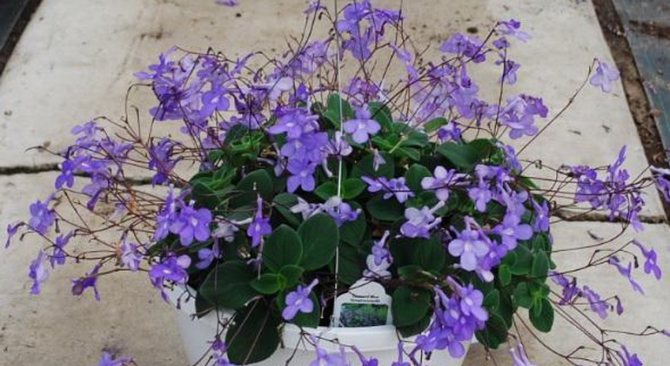

How to keep streptocarpus in winter
Usually, the plant has a dormant period in the autumn-winter season. But this is an optional condition: under artificial illumination, it will continue its normal existence.
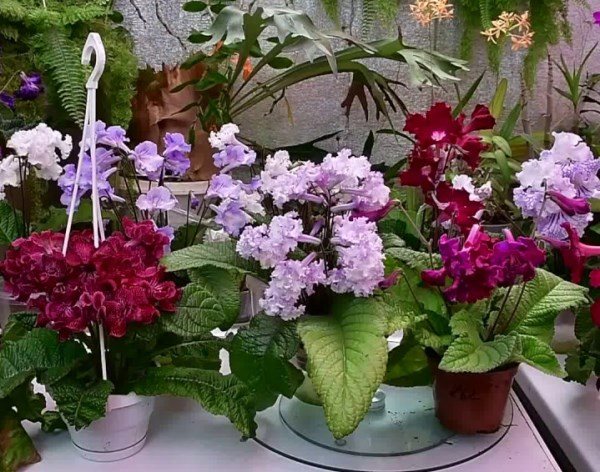

If streptocarpus is at rest, you should lower the temperature, reduce watering. Do not put in a dark place, provide 7-8 hours of light.
At the end of February, the flower will begin to activate. It can be transplanted into a new soil, after a month, start feeding, then follow the usual rules of care.
Diseases and pests
All streptocarpella diseases can arise from a violation of the conditions of detention or infection from neighboring plants. These can be fungal, viral or insect infections such as thrips, spider mites or other parasites.
Waterlogging of the soil, a sharp drop in temperature, dry and hot air, drafts - these are the enemies of any house plant that can arise only with the connivance of man.
Therefore, the best way to protect a flower from infections and insect attacks will be prevention, that is, timely spraying the soil with fungicides (Fundazol) and arkacids (Fitoverm), and strict adherence to the rules of care.
Treat plants with care and love. Remember: "We are responsible for those we have tamed." And streptocarpella will soon surprise and delight with the luscious greenery of emerald leaves and an air cloud of soaring "moths".
Raising children
As the children grow up, they should be transplanted into larger pots. If at first even a humus tablet was enough, now you may need a pot of about 9 cm. At the very bottom, drainage must be placed and filled with a mixture of 5 parts of peat, 2 parts of perlite and 1 part of humus. Water gently when the ground is completely dry. Begin feeding with nitrogen and potassium immediately to stimulate growth, but at a lower concentration.
When the "baby" is getting ready for the first flowering, it is better to remove the buds to give the plant a good strength. At the same time, you can transplant it into a pot suitable for adult plants. Its diameter should be about 11 centimeters, but a great depth is not needed. The pot is filled with a mixture of earth, peat and perlite.
General information
DESCRIPTION
The streptocarpus plant is rosette and has a low stem. The leaf plates are a fluffy wide-lanceolate shape. The color changes from green to variegated. Flowers can be single or collected in bunches of 2 pieces. The name "streptocarpus" is derived from the spiral shape of the fruit in the form of a long capsule. The culture blooms from early spring to autumn. In winter, the flower has a short period of rest, but the bush does not shed its foliage.
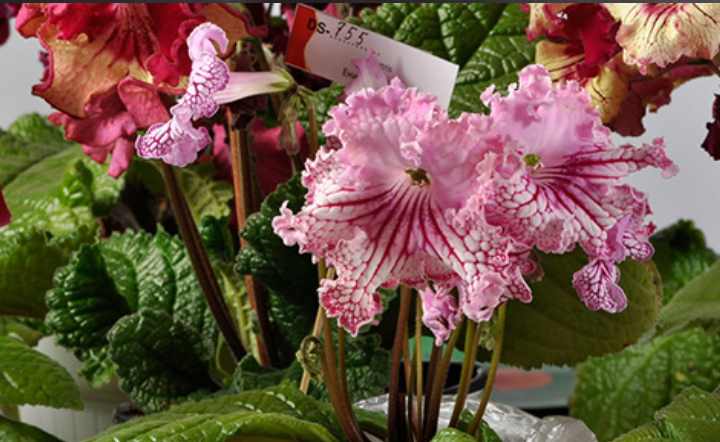

REPRODUCTION
Streptocarpus reproduce in several ways, which have their own characteristics.
- Cluster division method
The method is suitable for an adult plant that has grown well. At the time of transplanting the culture, it is taken out of the pot, the roots are cleared of the earth and the bush is divided. The separated bushes are left to dry a little, and the cut sites are treated with activated carbon. Then they are dived into new pots, sprinkling the root collar as it was deepened before transplanting. A prepared substrate is used as a powder. The soil in the pot is compacted and watered with warm water. For quick adaptation, the pots with plants are covered with cellophane and left for a week. Don't forget to ventilate! After a little time, the bush that has grown from the cut will begin to bloom.
Interesting fact! You can speed up rooting and enhance the growth of young foliage by shortening or cutting off large leaf plates. The plant will begin to bloom in a couple of months.
- Leaf propagation method
The easiest way to propagate from a leaf, which growers resort to more often. It uses part of the leaf plate that is well developed and healthy (no pests and diseases). You can cut it off in several ways: 1) Cut off a leaf with a petiole at the base and put it in water until the roots appear.
After they appear, the leaf is planted in moist soil and covered with a bag to create greenhouse conditions. 2) Place the sheet face down on a board and use a sharp knife to divide it perpendicular to the midrib into strips 50 mm wide. The lower and upper parts are thrown out. The cut site is dried and processed with powdered coal. Then they are planted in moist soil with a cut down at an angle of 45 degrees and a depth of 0.5 cm. On the seamy surface of the plate on the median vein, it is necessary to make twenty-millimeter cuts every 2 cm. Then the leaf cutting with the seamy surface is attached to the surface of the moistened substrate, after which it is sprayed with a fungicidal agent.
The leaf is covered with foil to create greenhouse conditions. With proper care, after two months, the fragments of the leaves are overgrown with children, which can be planted after four months. Children should be seated when their length reaches two centimeters.
- Seed propagation method
This method is more suitable for experienced growers than beginners.In order to collect the seeds, it is necessary to wait until the plant begins to bloom. Ripe seeds are picked and dried together with seed pods. The use of food containers with holes will be a convenient option for seating. A layer of expanded clay is laid out at the bottom of the container, and soil for streptocarpus is poured on top. Then the seeds are scattered over the surface of the ground and sprayed with a spray bottle.
The top of the container is covered with glass or foil. Watering is carried out through the pallet. After the shoots appear, the greenhouse is ventilated so that moisture under the glass does not get on the shoots. They remove the shelter after ten days. When the shoot gets stronger, it is dived in separate containers and looked after as if it were adult plants. They will bloom after ten months.
Important! When propagated by seeds, varietal traits are lost.
If bushes of streptocarpus of various species are cultivated, then it is recommended to stick labels with the name of the variety on the pots.
Interesting fact! Seeds can be sown several times a year, and this can be done at any time of the year. Thanks to this, you can get bushes that will bloom at different times.
However, if you dream of a beautiful perennial, which even a beginner grower can take care of, then you definitely need to replenish your home green garden with it.
BLOOM
The flowering period lasts from April to late autumn. Moreover, flowering often begins already in the flower babies. It can bloom all year round under favorable conditions for it, it does not have a dormant period. When the buds have faded, you should immediately remove the peduncles. They are cut at a height of 1-1.5 cm from the surface of the leaves. Plucking or pulling out the peduncle is not recommended, as streptocarpus grows flower buds in the depth of the leaf rosette constantly, and you can damage the remaining flower buds and interrupt flowering ahead of time. The lower leaves can be cut with a knife after the flower stalk has faded.
Interesting fact! If there are up to ten peduncles in the leaf axils, then long-term flowering is ensured.
One of the conditions for long-term and long-term flowering is a change in the substrate with each subsequent transplant. You need to regularly add nitrogen, phosphorus, potassium to the soil. As you know, nitrogen promotes growth, and phosphorus and potassium promote stable flowering. Also, fertilizers are needed in greater quantities if the leaves of the flower are pale.
Flowering may not be observed for some reason.
First reason: flowering is not observed only in the winter months. This means that the plant variety blooms only in the summer (from April to November).
The second reason: insufficient age. Perhaps the plant is still young and is only gaining sufficient green mass and will soon begin to gain green mass.
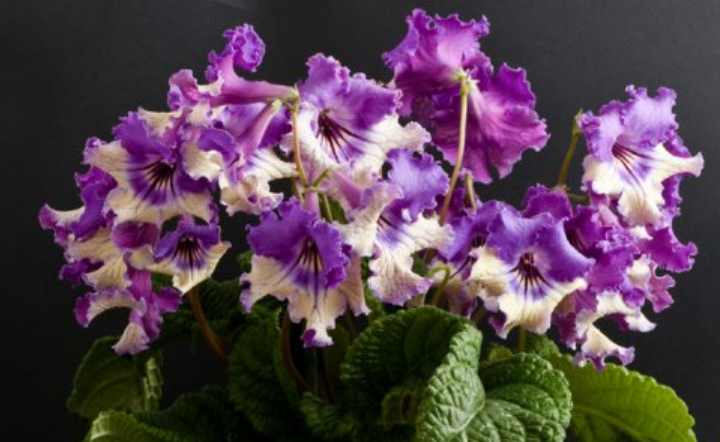

Third reason: errors in the content of the flower. The plant is mature enough with a large leaf rosette, but does not bloom. Rather, it simply does not have enough sunlight. You can easily solve it: by placing the pot on the southern windowsill, but not under direct rays.
Fourth reason: excessive watering of the plant. The roots begin to rot from abundant watering. In this case, there may be no flowering and no bud formation. The flower must be removed from the pot, damaged roots removed and treated with activated carbon. Plant in new soil with a new drainage layer at the bottom of the pot. By the way, the pot is disinfected before this.
Fifth reason: lack of nutrients in the soil. Apply the necessary fertilizer for decorative leafy indoor flowers.
Sixth reason: dense bushes. This is possible due to the appearance of the main leaves on the petioles instead of the peduncles of single small leaves. They should be removed so that they do not thicken the plant and do not interfere with the development of the long-awaited peduncles.
Varieties
In indoor plant growing, hybrid varieties of streptocarpus are often grown, among them the following varieties are the most common:
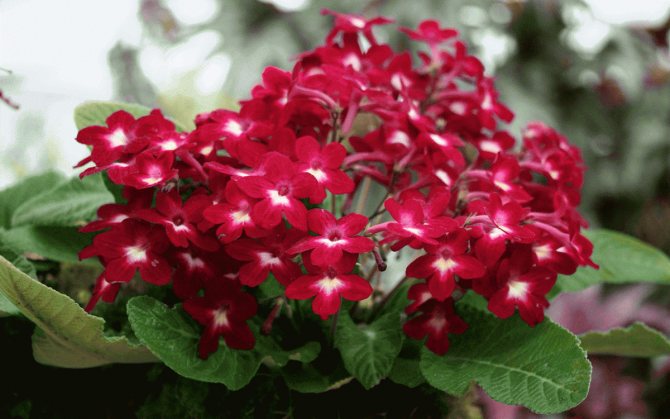

Texas Hot Chile is a slow-growing compact streptocarpus that has deep scarlet flowers with a yellow eye.
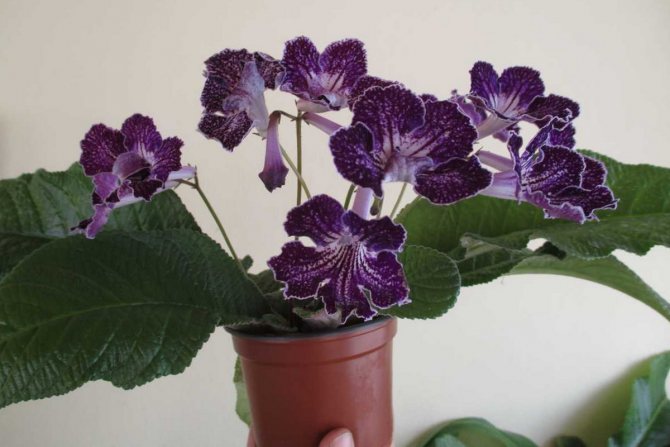

Stem-forming - the stems are extended by 4-60 cm, they have drooping azure inflorescences.
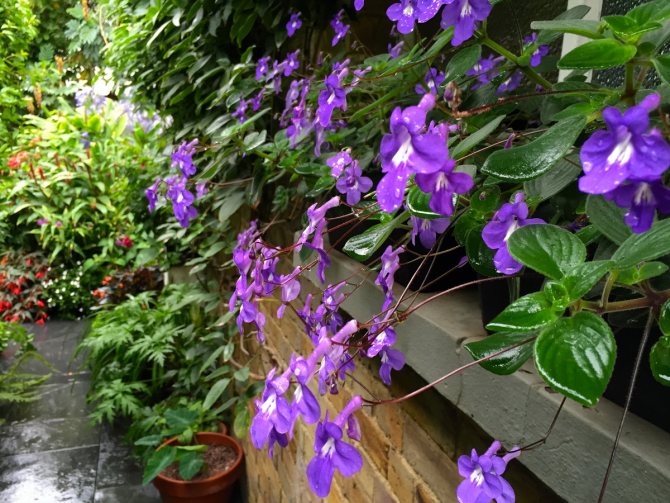

Streptocarpus Skalny, otherwise - a fake African violet - the most demanding in relation to the temperature and humidity in the room. Perennial with a woody base, twisted shoots at the ends, pubescent foliage, light green, rather small. The flowers are small, purple in color, the flowering period is autumn and summer.
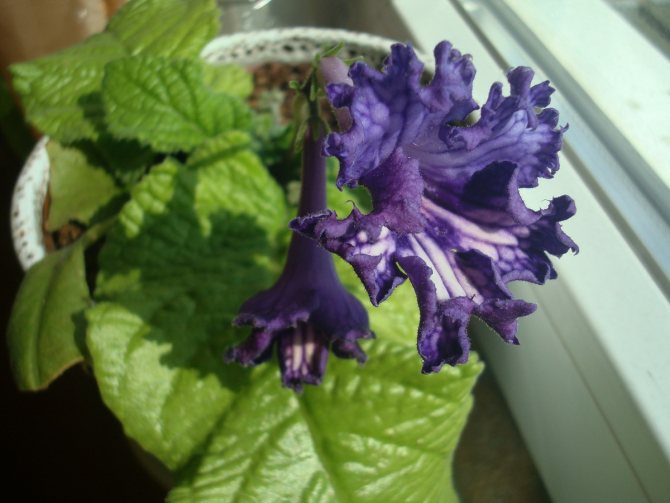

Royal - the leaves are pubescent, retracted, up to 25 cm long. The flowers are purple, with purple streaks and strokes inside the throat. It is the progenitor of many hybrids.
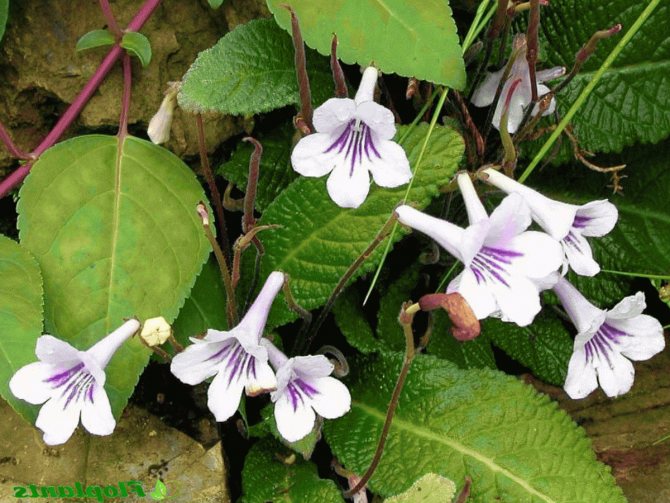

Fashion Statement - ordinary, large inflorescences. The top pair of petals are white and the bottom 3 are white with an ink-colored mesh. In the area of the throat, this mesh turns into an even purple tone.
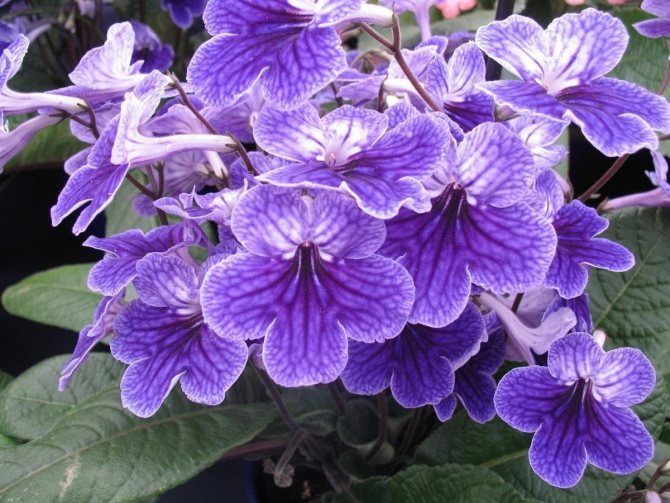

Blueberry Butterfly is a medium-sized blue inflorescence with purple rays on the 3 lower petals.
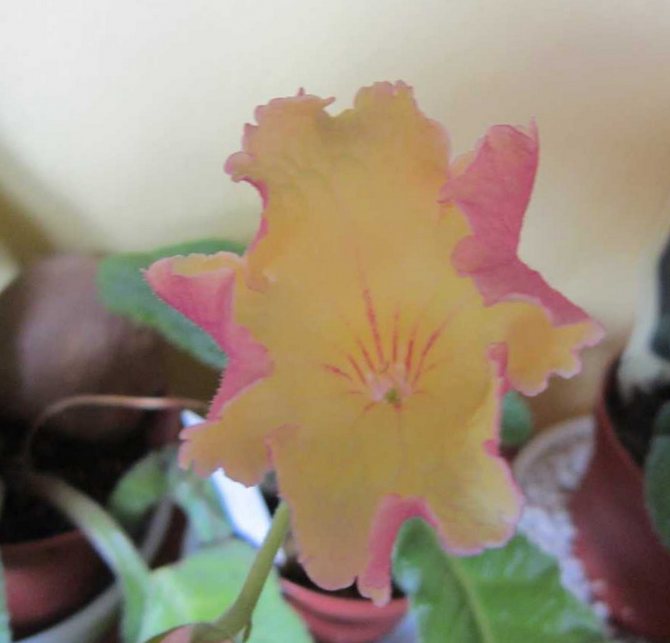

Salmon Sunset - simple medium-sized inflorescences, colored in a light orange color. The lower zone of the throat is yellowish with a burgundy spot in the shape of a maple leaf.
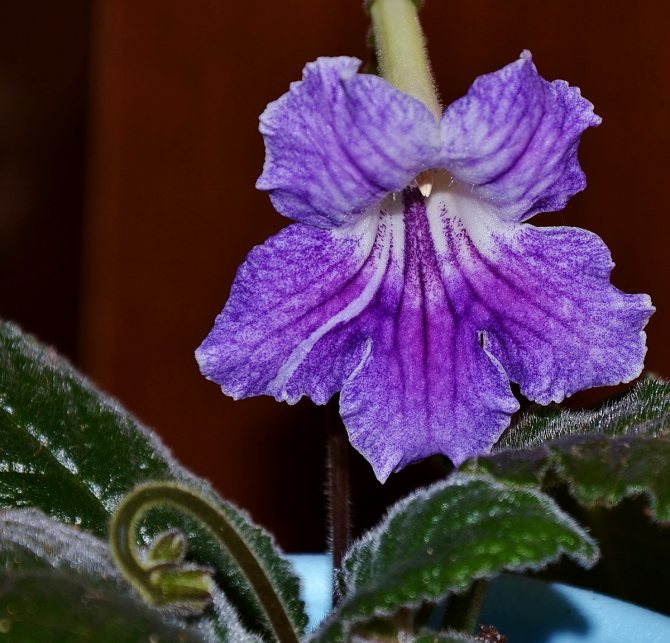

Pickaxe - height 10-15 cm, flowers are painted in light purple, inflorescences in the form of umbrellas.
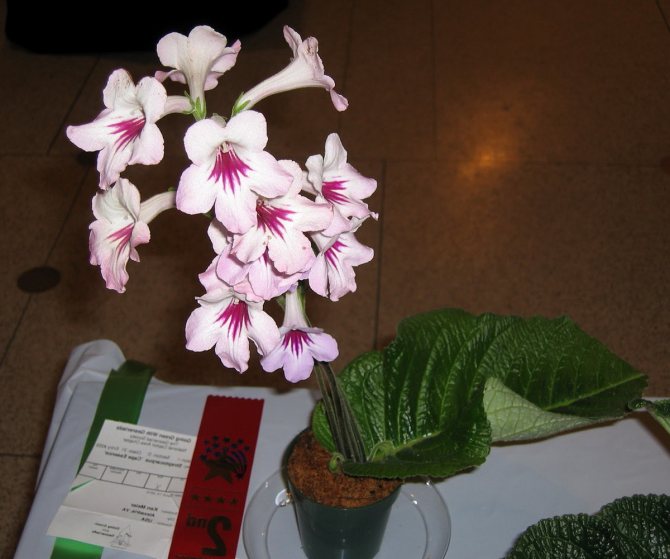

Wendland - the only large leaf grows, which sometimes grows up to 90 cm. The upper part of the leaf is green, in light veins, the back side is scarlet-purple. Wide oval shape, pubescence. The flowers are blue-purple, their diameter is up to 5 cm. There are 15-20 inflorescences on a long peduncle. After the completion of flowering, the plant dies, reproduces exclusively by seed.
Photo
Look at the photo of the flower.
Content
At home, from spring to autumn, the temperature of streptocarpus should not be lower than the average room temperature - 20-25 degrees. In winter, it is located in the range of 15-17 degrees.
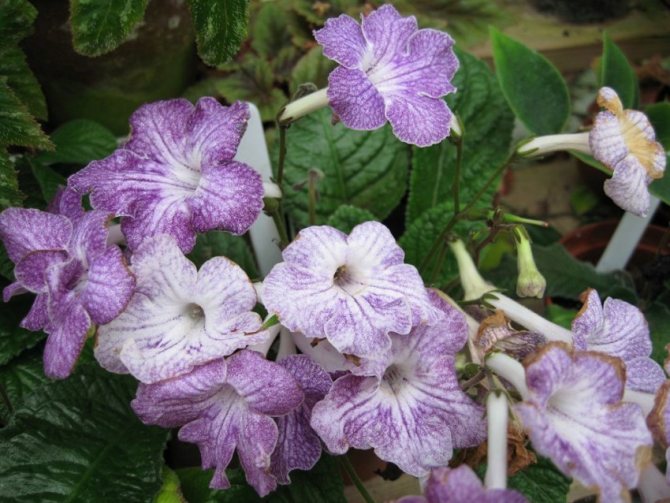

It is worth watering the plant in minimal amounts in winter and in moderate amounts during spring-autumn. The flower requires a fairly high air humidity, but you should not spray it. The plant itself prompts with the help of the leaves when it needs to be watered.
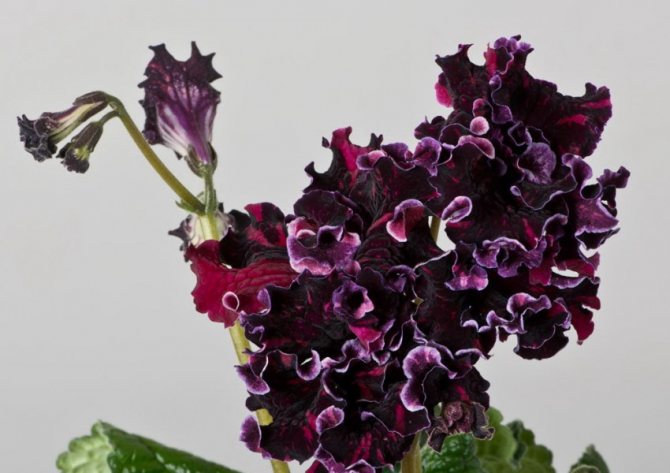

Photo gallery
Reproduction of Streptocarpus by seeds.
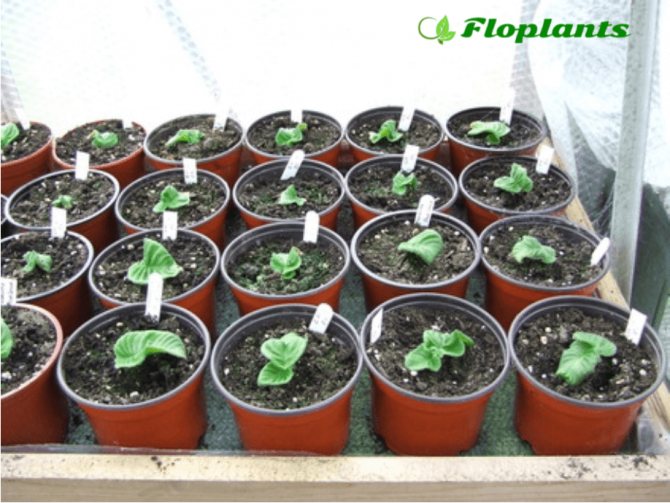

Plants obtained from seeds do not repeat maternal traits. Streptocarpus is prone to self-pollination, but you can also participate in this process, pollinate another flower with the pollen of one variety. The seed box turns brown after 1.5 months, when it ripens, it bursts and scatters the seeds around itself, so it is harvested a little earlier, wrapped in a napkin and put to dry. Seeds can be sown at any time of the year, the main condition for them is long daylight hours, up to 12 hours. The seeds are sown on top of the substrate, they are not covered with earth, a greenhouse is arranged above them, which must be regularly ventilated. The ideal temperature for germination is 22-25 ° C. The first shoots appear within 12-20 days. After a month, they can be dived.
Views: 240
How to propagate a plant?
Sheet
Reproduction from a leaf is considered the easiest... The bush flower expands due to the growth of lateral formed bushes and is easily divided into parts. Thanks to the division, the bush is rejuvenated.
From seed
This method, despite all the complexity, is considered the most interesting. Reproduction from seeds is a great opportunity to create a new species of plant that can be given its own name. To grow seeds, two plants are used, which pollinate each other.
Now you know how streptocarpus reproduces.
Useful properties of streptocarpus
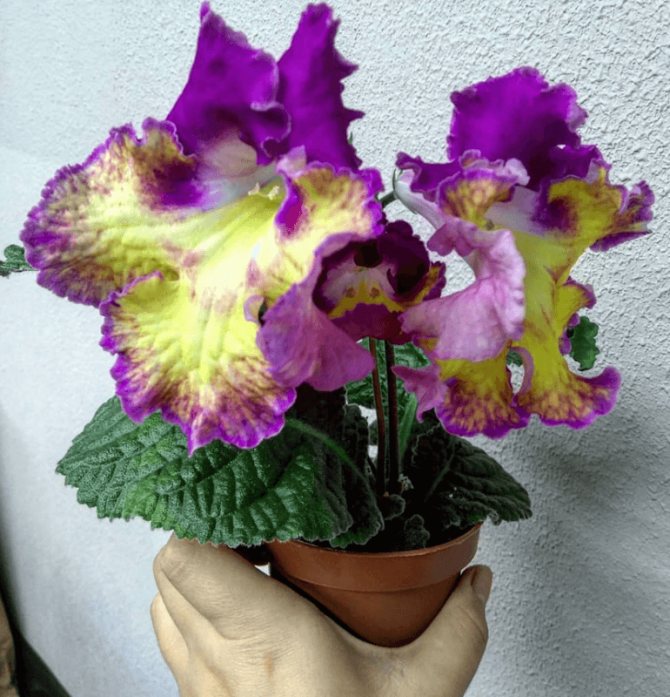

Streptocarpus is grown for decorative purposes. It looks good in any interior, not only during the period of abundant flowering. The rosette of young leaves also looks impressive. The plant is not toxic, but it also has few useful properties. Some hobbyists use it in small amounts as a hot seasoning.


